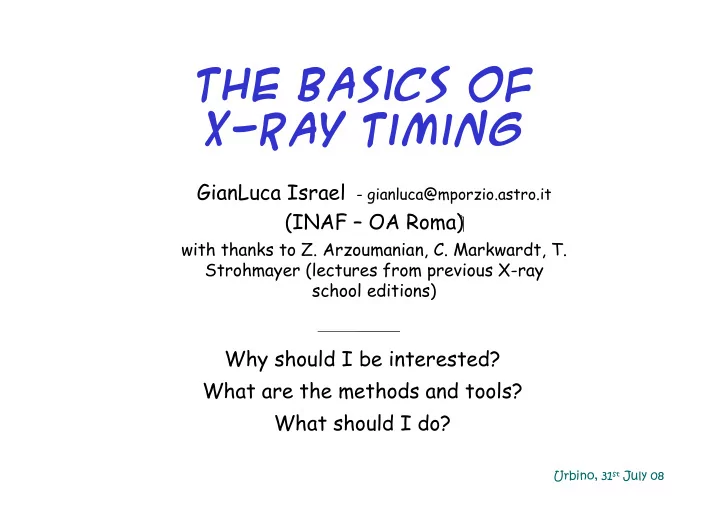

�������������� ������������ GianLuca Israel� � gianluca@mporzio.astro.it (INAF�– OA�Roma) with�thanks�to�Z.�Arzoumanian,�C.�Markwardt,�T.� Strohmayer (lectures�from�previous�X�ray� school�editions) • Why�should�I�be�interested? • What�are�the�methods�and�tools? • What�should�I�do? ���������� �� �������
������� • �������� �������� time�series�analysis�is�a�very�broad�topic,�and�difficult�to� cover�in�one�lecture. • ����� ����� present�the�most�important�topics�(partially)�not�discussed�in� the�previous�school�editions. • Timing�analysis�may�seem�a�“magic�box”,�since�it�can�reveal�features� that�are�not�apparent�to�the�eye�in�the�raw�data • Timing�“ analysis” is�around�since�a�long�time:�think�about� day/night,�seasons,�years,�moon�phases,�etc. �������� • The�relevance�of�timing�analysis • Basic�light�curve�analysis�(r.m.s.) • Fourier�power�spectral�analysis • Power�normalizations�and�signal�searches • Signal�detection,�signal�UL�and�Asens • Search�optimization • A�working�session�example� • Cross�Correlation ���������� �� �������
������������������������������ ��������� �!�"����������� �# • Timing��=>��characteristic�timescales�=�PHYSICS • Timing�measurements�can�be�extremely�precise!! • Binary�orbits – orbital�period – sizes�of�emission�regions� and�occulting�objects – orbital�evolution Spin�axis • Rotation�of�stellar�bodies – pulsation�periods Magnetic�axis – stability�of�rotation – torques�acting�on�system Accretion�phenomena broadband�variability “quasiperiodic” oscillations�(QPOs) bursts�&�“superbursts” X�rays Energy�dependent�delays�(phase�lags) ���������� �� �������
��$�����%����������������&����"����� � Isolated�pulsars������(ms–10�s) � X�ray�binary�systems Accreting�pulsars�(ms–10000�s) There�could�be� • Eclipses��������� (10s�min–days) variable�serendipitous� Accretion�disks��(~ms–years) sources�in�the�field,� Transients�orbital�periods�(days�months) especially�in� Chandra � Flaring�stars�&�X�ray�bursters and� XMM� observations � Cataclysmic�Variables�(s�days) � Magnetars ( µ s�s) � Pulsating�(non�radial)�WDs (min�days) In�short,�compact�objects�(&�super�massive�black�holes?)�are,� in�general,�intrinsically�variable. ���������� �� �������
%��$�����'����������&����"����� • The�root�mean�square�variability�(the�same�as�standard�deviation): • Also,�it�is�common�to�quote�the� fractional�r.m.s.,� r.m.s./<RATE> ������ the�above�def.�is�bin�size�dependent�(i.e.�You�miss�any� ������ variations�smaller�than�your�time�bin�size) …….�moreover • We�must�remember�that�the�light�curve�has�Poisson�counting� noise�(i.e.�Some�randomness),�so�we�EXPECT�some�variation� even�if�the�source�has�a�constant�intrinsic�intensity. ���������� �� �������
(���%)��������� – Hypothesis:�the�source�is�intrinsically�constant • Can�I�reject�this�hypothesis?�� • Chi�square�statistic • If�measurements�are�gaussian�(!),�the�statistic�should�have�a� chi�square�distribution�with�(N�1)�degrees�of�freedom. • We�can�calculate�the�statistic,�compare�to�tabulated�values,�and� compute�confidence�in�our�hypothesis. – An�alternative�test�for�variability�is�the�K�S�test Limits: Limits: • So�far,�our�analysis�has�focused�on�the�total�variability�in�a�light�curve. • This�method�cannot�isolate�particular�timescales�of�interest. • If�we�are�interested�in�faster�time�scales�(higher�frequencies),�we�must� make�a�light�curve�with�smaller�time�bins • The�assumption�of�gaussian�statistics�eventually�fails,�when�the�number� of�counts�per�bin�is�less�than�~10,�and�this�method�is no�longer�useful. ���������� �� �������
%���������*+�+ Light Curves Note�that�all�light�curves�have�50%� fractional�r.m.s.�variability ������������ TOTAL�variability�(r.m.s.)� ������������ does�not�capture�the�full�information.�Its� time(scale�or�(frequency�scale)�is important�as�well. ���������� �� �������
,�������+������� • This�important�technique�comes�from�the�theorem�that�any�signal can� be�written�as�a�sum�of�complex�exponentials: - • The� a k terms�are�known�as�Fourier�coefficients�(or�amplitudes),�and� can�be�found�by�using�the�Fourier�transform�(usually�a�FFT).�They�are� complex�valued,�containing�an�amplitude�and�phase. • Once�we�know�the�Fourier�coefficients,�we�have�divided�the�time series�into�its�different�frequency�components,�and�have�entered the frequency�“domain.” • Parseval�proved�that:�� Var[f j ]�= the�left�hand�side�is�the�total�(r.m.s.) 2 variance,�summed�in� time ;�the� right�hand�side�is�the�same�total�variance,�summed�over� frequencies . The�values�are�known�as�Fourier�powers,�and�the�set�of�all�Fourier� powers�is�a�POWER�SPECTRUM�(PSD). ���������� �� �������
,�������+��������- Light Curves Instrumental�noise�not�included�!�When�dealing�with�noise�one�also�need a�statistical�tool�to�handle�it. ���������� �� �������
(��$�������������������%$����� • Power�spectra�are�commonly�normalized�in�two�different�ways. • The�“Leahy” normalization�is�useful�for�computing�significances� (DETECTION).�In�the�following�we�will�refer�to�it�as�the�default • The�“density” normalization�is�useful�for�computing�fractional�r.m.s.� Variabilities�(PHYSICS) ������������������� • N ph is�the�total�number�of�photons • With�this�normalization,�the�Poisson�noise�level�is�distributed like�a� χ 2 with� ν =2N PSD degrees�of�freedom�(in�units�of�counts;�� N PSD� is�the�number�of�averaged�PSD) – E[ χ 2 | ν ]�=� ν � 2�for��N PSD =1� � σ [ χ 2 | ν ]�=�sqrt(2 ν) � 2�for� N PSD =1� � noisy ���������� �� �������
./��$��0�+�������������������"���� ��'. ����� XTE�J1751�305:�accreting�ms�pulsar.� ��� Period�drift�testifies�of�an�orbit� ��� with�period�of�~40min ~2 ���������� �� �������
./��$��0�1��� �����2%��������� Sub�ms�oscillations� Sco�X�1 seen�from�>�20�NS� binaries Frequencies�saturate��������������������� • to�a�maximum.�This�is� likely�the�signature�of� the�``innermost�stable�circular�orbit''�around� a�neutron�star,�a�radius�predicted�by� general�relativity�inside�of�which�matter� must�inexorably�spiral�down�to�smaller�radii ���������� �� �������
./��$��0�'������� ��"����1�� � The�shortest�period�in�(X�ray)� astronomy • SGR1806�20�Giant�Flare�(Dic 2004) • A�sequence�of�QPO�frequencies�was� detected:�18,�29,�92�and�150,�625,� and�1840�Hz! ~2 • Amplitudes�in�the�5�– 11%�range. • ���������������������� ���������������������� A�sequence�of� • toroidal�modes ���������� �� �������
Recommend
More recommend